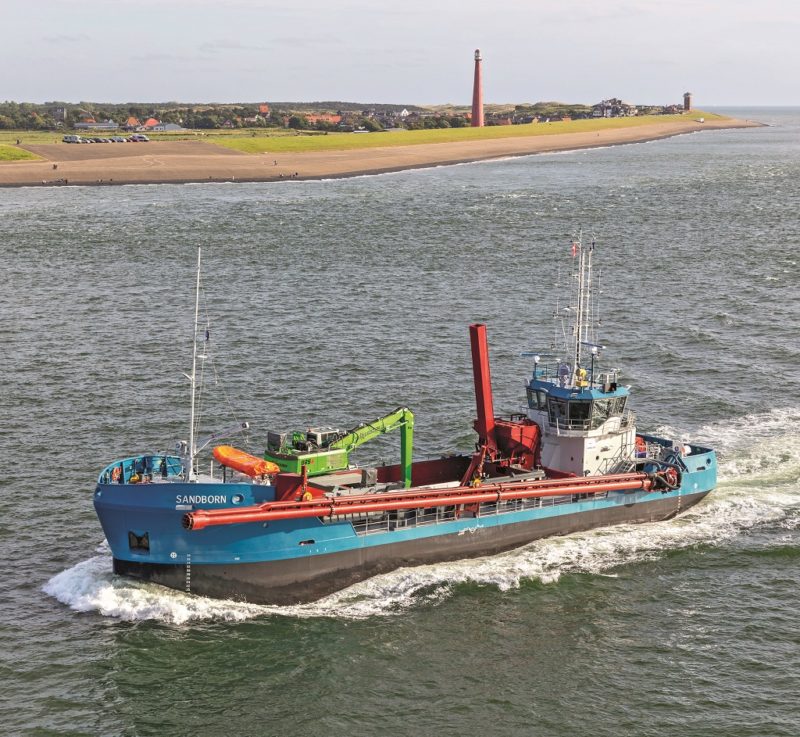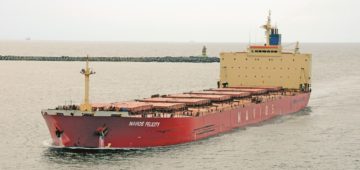The focus of this month’s newbuild feature comes from the plethora of vessels designed and built to undertake dredging tasks around our coastlines. The EuroHopper 400 is a coastal waters example of a Trailing Suction Hopper Dredger (TSHD) that was spawned by Neptune Marine, a company that can trace its routes back to 1972 when the yard opened in Aalst, The Netherlands, as a builder of luxury yachts. That activity was soon joined by the manufacture of workboats where the expertise gained thus far plus the culture of working to the highest standards reaped rewards. Such was the success of the workboat division that, in 2001, the two activities were separated into Neptune, focussing on workboats, and Elling Luxury Yachts. Over the years the company has expanded, gaining additional facilities in Hardinxveld and Groningen. In 2005, Neptune Marine started its marine services activities. By offering charter equipment, including pontoons and deck equipment, to operators and contractors, the company can deliver solutions for any kind of project. The scope of services has expanded over time in response to customer demand so the range of workboats has been supplemented by pontoons, high speed and offshore vessels of various types. In 2010 a successful repair, conversion and mobilisation service was added to the portfolio. The EuroHopper family also includes the EuroHopper 200 (200m3 capacity), EuroHopper 300 (300m3 capacity), EuroHopper 600 (600m3 capacity) plus the Clan Dredge, a 700m3 dredging crane vessel for harbours and waterways. The EuroHopper range is designed and built to work the toughest environments, undertaking maintenance dredging projects in ports and coastal areas, as well as sand and aggregates extraction, for land reclamation, construction and other purposes.
Records show that IHC Dredging of The Netherlands built the first trailing suction hopper dredger over a century ago, a unique type of ship. While slowly sailing, a TSHD trails a suction pipe off the side of the hull. At the entrance of a suction pipe is a draghead. This draghead collects the soil like the mouth of a vacuum cleaner. The slurry is pumped to the hopper (hold) and stored for transport. When full, the TSHD sets sail to the discharge location. TSHDs are allrounders by nature and are capable of handling many different dredging projects. They can be put to work anywhere in the world. Also, a TSHD is the only type of vessel that dredges while sailing, making it the dredger of choice for operations in waters where tides and swell occur, and where any interference with the movement of shipping is not possible. The EuroHopper 400 example that forms the subject of this article is the 467gt/2022-built Sandborn, which was ordered for Sibelco’s operations in the port of Rønne, Denmark (Sibelco Nordic A/S). The site there is located off Norgesvej, is managed by around 20 people and has its own dredging operation. Here, the company produces classified material, supplying drained quartz, aggregates and sand to customers. The site has its own loading operation for working with ships under 6,000gt.
The year 2022 is Sibelco’s 150th anniversary, the company being founded as Sablières et Carrières Réunies on 4th April 1872 (today known as SCR-Sibelco) in Belgium by industrialist Antoon Van Eetvelde and Crédit Général Liégois. The young company, with ambitions to mine quartz sand for industrial applications, grew quickly and was soon trading internationally. Export to the UK was established by 1880 and the first activities in Nivelstein (Germany) also began then. In 1935 SCR constructed its first plant for drying and grinding silica sand, including a unique hydro-classification system to divide mineral sludge into fine and coarse flows. By the end of the 1930s, SCR was producing six grades of sand. This technology later served as a model in Sibelco’s expansion worldwide. In 1955, SCR set up a new plant in Dessel for drying and grinding a special type of quartz sand known as Sibelco (a name derived from Compagnie Belge des Silices). Sibelco also established its headquarters in Antwerp. The new plant in Dessel subsequently served as a prototype for other Sibelco facilities. An impressive series of expansions over the decades now makes Sibelco a global material solutions company, sourcing, transforming and delivering speciality industrial minerals with a strong focus on silica, clays, olivine, cullet (recycled glass) etc.

Born to Dredge
The origins of the vessel’s name could not be ascertained at the time of writing, and the translation of Sandborn from Danish to English produced the same meaning. Sand Børn translates from Danish as “True Child” which, as she is a “baby” dredger, could be quite appropriate! However, the meaning of “Born upon the sand” seems the most likely choice considering the duties performed. So many ship names nowadays are rather banal but something with meaning always adds interest. The original version of the EuroHopper 400 depicts a vessel with the deckhouse located in the bow, with all equipment and hopper sited aft of this. However, version No.2 is a more conventional layout with the deckhouse at the stern, which is the form that the Sandborn takes. The vessel was built as Yard No. 554 at Neptune Marine BV’s Aalst shipyard in The Netherlands. The order was placed in June 2021, the keel laying date was December 2020 (suggesting that the build commenced speculatively) and the launch followed in June 2022. The Sandborn is 43.20m long overall with an overall beam of 11.82m, a hull depth of 4.00m and a loaded draught of 3.38m. The freeboard, a specification rarely quoted nowadays, is 630mm. The net tonnage is 140, and deadweight figure is 720 and the hull is entirely fabricated from steel. There are five watertight compartments and the hopper capacity for the dredged materials is 434.41m3. The trailing suction dredge system is mounted along the port side of the hull and the trailing pipe has a 350mm diameter capacity, as does the diesel-driven dredge pump. There is also a jet water pump and the maximum dredging depth is 15m below sea level. The trailing pipe (approx. 32m long) is raised/lowered via a cable pulley system mounted mid-ships and at the bow. When in the stowed position, the suction arm gives the impression that the ship is about to engage in some jousting! The dredge pump room is located port side aft at below-deck level with the dredged material being fed up to a hopper mounted on the main deck in front of the deckhouse. The aggregates are then fed into the cargo hold (hopper) via a hydraulically operated chute. The hopper is on runners, moving the width of the hold. At the forward end of the hold is a cargo handler mounted on a rail gantry system that allows it to operate anywhere along the length of the aggregates hopper. This handler is a 26,120kg Sennebogen 825E with a maximum outreach of 14m. The machine is equipped with a clamshell for unloading requirements and is powered by a 6-cylinder and 145kW Cummins QSB 6.7 engine. The 825E is equipped with an E270 MaxCab that can be raised hydraulically to provide the Operator with eye level visibility of up to 5.4m, depending on the operational requirements and environment. The aggregates hold can also be emptied via hydraulic shell doors built into the ship’s hull. This also allows the vessel to undertake general dredging duties as well as aggregate cargoes that are destined for the quayside. An optional bow coupling nozzle for rainbow discharge is also available for the EuroHopper400, as well as a submersible dredge pump.
The main sphere of dredging operations generally takes the vessel no further than 8 miles from the coast. At below-deck level either side of the hold are the 17.60m3 capacity fuel tanks plus void spaces along the port side and a space on the starboard side for a future battery room, indicating that the Sandborn is hybrid-ready. Below decks aft is the machinery room, which adjoins the pump room. Here can be found 3 marine diesel engines and one generator. The diesel electric propulsion system consists of two 368kW, 6 cylinder and 1800rpm engines that drive two electrically powered azimuth solid thrusters in nozzles, with a diameter of 1250mm. The 125HP generator has an output of 115kVa/92kW. The ship’s diagram shows three marine diesel engines but the redundant unit’s primary use is to operate the dredge pump. An electrically driven transverse thruster is located in the bow, the ship’s service speed is 9-10 knots and the funnel is located aft of the wheelhouse on the starboard side. The vessel has a maximum crew of 4 persons and, within the 2-storey deckhouse on the main deck is the messroom and galley. The deckhouse is offset inwards from the port side to make space for the dredging system, so the wheel house is not full width. However, the port side of the wheelhouse is extended forward to provide a control and observation platform for dredge and on-deck operations. The crew accommodation is located within the bow at main deck level and consists of the Officer’s cabin (port side¸ 7.5m2), a 7m2 and 5.6m2 cabin for 2 crewmembers (midships) plus a 7.5m2 Captain’s cabin (starboard side). Forward of the cabins is the chain locker in the Forepeak. At below-deck level in the bow is a Deck Store (port side), changing room and food store (starboard side) plus a toilet and shower.
Sand and Deliver
After her sea trials, the Sandborn was delivered to Sibelco Nordic A/S on 12th July 2022 and also christened, although no naming ceremony details were provided. The newbuild then departed for her new home port of Rønne, the largest town on the Danish Island of Bornholm, a voyage that took her via the Kiel Canal to the Baltic Sea. The Sandborn replaces the 377gt/1977-built and 40m long/9.22m beam suction dredger Ahlsell. The 610dwt vessel hadn’t been in operation since 6th July 2022 according to AIS records and had served Sibelco Nordic A/S since 1991.






Comments
Sorry, comments are closed for this item